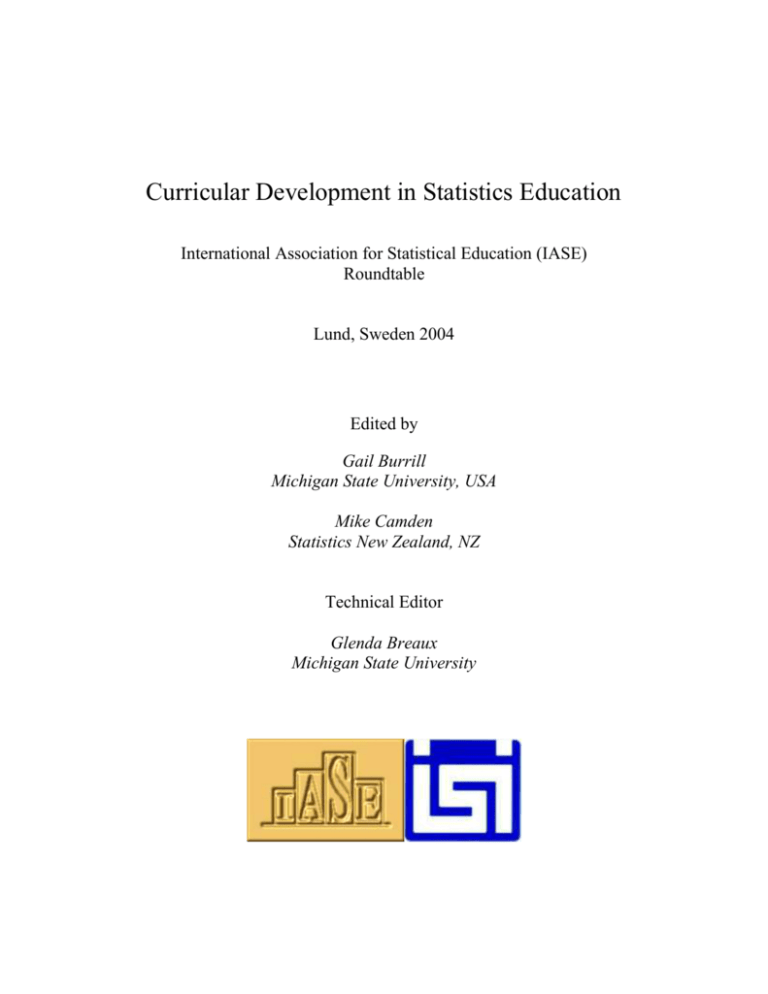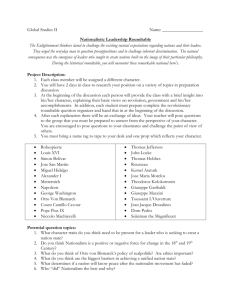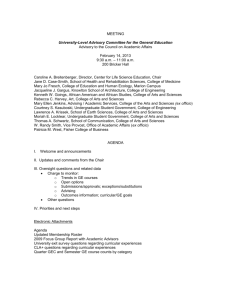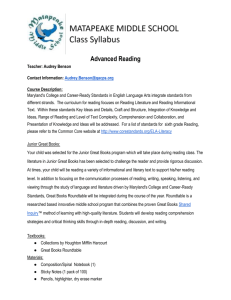
Curricular Development in Statistics Education
International Association for Statistical Education (IASE)
Roundtable
Lund, Sweden 2004
Edited by
Gail Burrill
Michigan State University, USA
Mike Camden
Statistics New Zealand, NZ
Technical Editor
Glenda Breaux
Michigan State University
2005 International Statistical Institute
Voorburg, The Netherlands
All rights reserved. This book, or parts of it, may not be reproduced in any form without
permission of the publisher.
ISBN 90-73592-22-4
Published by the International Statistical Institute
© 2005 International Statistical Institute, Voorburg, The Netherlands
2
Preface
From 28 June to 3 July 2004 the International Association for Statistical Education (IASE) held a
Roundtable on Curricular Development in Statistics Education in Lund, Sweden. This roundtable
provided a forum for 26 participants from nine countries to consider aspects of the statistics curriculum
from primary school to the tertiary level and across courses in statistics, mathematics, teacher preparation,
and stochastic processes. The backdrop for the papers and discussion was:
Research - What do we know and what do we need to know?
Policy - Who is responsible for developing and putting in place a curriculum?
Practice - What is important to teach, when should it be taught and how?
The papers were clustered into five sections: 1) Curriculum Perspectives and Statistics Education,
2) Curricular Approaches to Teaching Statistics, 3) Content Issues Related to Teaching and Learning
Statistics, 4) Statistics Education Research and Implications for Teaching, 5) Policy Decisions and
Implications for Curriculum Implementation. The discussion ranged from the development of a statistics
curriculum to common issues and promising solutions to questions of how to best construct learning
trajectories that will enable all students to make sense of data and to apply statistical reasoning when
making decisions based on data. The conversation was framed by questions such as: How do we help the
world understand that statistics education is vital in a world where social policy, technology,
environment, allocation of resources depend strongly on careful design of investigations and very fine
analysis of data? What topics are important to teach? When and how should the important topics be
taught? How do we carefully structure the curriculum? What do we know about when and how
particular concepts should be taught? How can we make statistics education more inviting? What do we
know about teaching and learning statistics? What do we still need to know? How does research on
statistical education link to practice? Who is responsible for developing and implementing the
curriculum?
Several themes emerged from the papers presented at the Roundtable and the discussions that
ensued. These are elaborated on below.
Frameworks
The role of frameworks as a guide to thinking about curriculum development in statistics,
assessment, conceptual understanding, and teachers’ practice is discussed from several perspectives.
Andy Begg offers a general framework for curriculum development and cautions that developers should
be mindful of the fact that learning is not linear. He suggests it might be more appropriate to think about
curriculum as a set of cycles. Milo Shield lays out principles or central elements to guide the design of a
statistical literacy curriculum for a survey course for non-majors at the tertiary level. He believes that
using these principles would lead to new ways to teach concepts such as association, confounding, and
statistical significance that are more in touch with the students’ needs and futures.
Chris Reading and Jackie Reid describe an approach that involves the use of “minute papers” and
discuss how this work relates to Maxine Pfannkuch’s framework for theoretical statistical thinking. Jane
Watson and Rosemary Callingham discuss their use of Pfannkuch’s curricular framework in assessing
statistical literacy. Using the framework, they created five levels of understanding for key content
strands: 1) recognition of the need for data; 2) transnumeration (changing representations to engender
understanding); 3) consideration of variation; 4) reasoning with statistical models; and 5) integrating the
statistical and contextual.
Maxine Pfannkuch reports her research on how the statistical thinking framework affected
teachers’ practice. The goal of her work was to start teachers on a pathway toward a gradual change in
their teaching, toward an approach that fosters statistical thinking. Teachers make the statistical thinking
framework concrete in their instruction, and, conversely, teachers and researchers use the framework to
3
analyze instruction. In each of these settings as well in several other papers, the case is made for
beginning with a clear and well-articulated framework that could inform the development of some facet
of teaching statistics and the analysis of how this development unfolds. Anthony Harradine describes six
phases of teaching and learning in the progression towards the goal of reasoned decision making based on
sound statistical thinking.
Statistical Thinking and Reasoning
Students seem to be mastering statistical procedures and vocabulary but are not able to use
statistical reasoning in a meaningful way. This lack of students’ ability to reason and think statistically is
of concern in papers describing students at all levels from elementary students to those at the tertiary
level. While discussing research and its implications for teaching, Helen MacGillivray comments that an
over-emphasis in school syllabi on answering questions rather than posing them, and making decisions
based only on data displays produces an approach based on absoluteness of data that stifles the
development of statistical thinking. Jim Ridgway, Sean McCusker and Jim Nicholson identify this as an
issue for students aged 9 to 13 years after examining assessment results and finding that top students were
unable to interpret data and apply their statistical ideas in practical situations. They claim that current
specifications in statistical education often focus on a rather narrow range of techniques that are
applicable only to univariate and bivariate analyses. The main emphasis is primarily on the mechanical
skills of constructing specified graphs correctly or “reading the graph”’ to extract detailed information
rather than on equipping students to become informed citizens in a society where they will be required to
deal with complex data sets. As one curricular approach, Ridgway, McCusker and Nicholson describe an
intervention they designed that includes a series of technology-based problem solving tasks that can be
integrated into the curriculum. They also report on the design principles for such tasks that seem to be
emerging from their work and on evidence showing that students – some as young as nine years old– can
work with such data to reason about realistic situations and produce sensible conclusions.
While also discussing curricular approaches, James Matis, Linda Riley, and Tim Matis observe
that the curriculum of many introductory courses at the collegiate level is frequently centered solely on
the theoretical underpinnings of the subject, with limited exposure to its use as a tool for modeling and
analysis. They observe that the subject is often illustrated with simple mathematical exercises that have
no practical application or with projects that do not actively involve the students. As a consequence, they
found students unable to transfer their knowledge to real contexts. To counteract this, they designed
laboratory modules via digital video media that present real-world applications of stochastic processes
that can be integrated into coursework. The modules engage the students in problem solving in an
applied context and, as part of completing each module, ask them to deliver a comprehensive oral and
written report directed towards a non-technical audience.
From a very different perspective, Allan Rossman and Beth Chance suggest that the “math stat”
sequence often presents a full semester of probability before proceeding to statistics. They also suggest
that in this sequence the statistics covered is often abstract in nature and does not give students a modern
and balanced view of the applied as well as the theoretical aspects of the discipline of statistics. They
argue that, in fact, students often leave this course with less intuition and conceptual understanding than
students who have taken a lower level course (e.g., data collection issues, statistical vs. practical
significance, association vs. causation, robustness, diagnostics, etc.). In response, they have developed a
course to support a data-centered, active learning pedagogical style at the post-calculus level. Key
features of the course materials include:
Student-conducted investigations of statistical concepts and properties.
Probability models introduced in the context of statistical ideas, applied to real data.
Technology used as a tool for such techniques as simulation and to assist with graphical displays
and investigating effects of parameter changes.
Explorations of data from scientific studies, popular media, or student-collected
4
Assessing Understanding
Several of the papers address ways to explore and measure student understanding of statistical
concepts and relate these to the curriculum. Nick Broers, Marieke Mur, and Luc Budé focus on selfexplanation as a way to bring out important statistical ideas and outline a method to direct students in
their self-explanation activity. Working with struggling second-year tertiary students, they found some
positive results after using concept maps when they compared the results on a conventional test assessing
conceptual understanding. When concept maps were used the instructor had to deconstruct the learning
material of a given knowledge domain into a finite number of elementary propositions, which together
cover all the relevant concepts and principles.
Watson and Callingham use a statistical literacy survey and code-book to monitor the progress of
students in grades six to ten in their development of the skills required for statistical literacy. They found
that most students remained at a level characterized by appropriate, but unquestioning, engagement with
context, and straightforward application of statistical skills associated with the calculation of simple
probabilities and means and graph reading. They argue that this finding suggest that more opportunities
need to be created for students to question critically statistical claims from media sources or other realworld contexts in order to develop the analytical habits of mind that are needed to respond critically to
quantitative claims.
Reading and Reid consider the degree of understanding of variation that is evident as students engage
in a tertiary introductory service statistics course with “consideration of variation” as a core for the
curriculum. Their work seems to suggest that the use of “minute papers” focusing on students’
understanding and reasoning, rather than merely their ability to perform calculations, can be a means of
evaluating how successfully the consideration of variation thread has been used to structure the integrated
curriculum.
Maria-Gabriella Ottaviani describes research in Italy demonstrating that better results may be
obtained in elementary school if teachers adopt a “concept net” approach, use class interviews as tools to
highlight both the individual’s and group’s knowledge, and build cognitive maps to check the progress of
concept acquisition by pupils.
Jun Li describes the relation between the curriculum and assessment in Shanghai when only four out
of 150 marks on the University Entrance Examinations in 1998 and 1999 were allotted to probability and
none to statistics. Li also discusses how this is expected to change with the adoption of a new curriculum
that includes statistics and probability.
Scaffolding the Development of Statistical Concepts
An approach with potentially significant implications for the curriculum is an emerging
perspective that involves introducing central statistical concepts such as measures of center or certain
graphical representations in ways that promote the development of understanding, rather than initially
beginning with definitions and instruction on routine procedures.
Arthur Bakker, Rolf Biehler, and Cliff Konold describe research on promising strategies for
helping students come to understand measures of center and for interpreting box plots, recommending
that early instruction in statistics focus primarily, if not exclusively, on plots in which individual cases are
visible. Based on their research they recommend that, when aggregate plots are introduced, the plots
initially are accompanied by representations that still allow students to see individual cases. One example
of representations that preserve information about individual cases involves box plots overlaid on stacked
dot plots.
In his paper, Harradine suggests that problems are traditionally posed in ways that require
students to read within, between, and beyond the data. That is, the student has to make comparisons
between two sample data sets and then hypothesize about what that may mean about the population from
which the data were drawn. He claims this is too much to ask, initially, for many students. He argues
that prior to teaching standard statistical tools and procedures, students should be taught the art of
5
“distribution division” where distributions are sliced into chunks and each chunking is considered to see
what information that particular slicing configuration conveys. He also argues that the application of the
skills of comparing and contrasting, and forming arguments that support a conclusion or conjecture
should be taught prior to teaching standard statistical tools.
Technology
The use of instructional technology (IT) in teaching statistics has created new opportunities to
present ideas dynamically and interactively to students, rather than in more conventional, ‘static’
environments. Technology use can also support the development of robust models of new sorts of
conceptual learning and understanding which can underpin teaching in IT-rich environments. This was
evident in the papers by Ridgway, McCusker and Nicholson; Mattis, Riley, and Mattis; Harradine;
Bakker, Biehler, and Konold; and Rossman and Chance. From another perspective, technology is used
both to deliver the central elements of a course and as a tool for analysis in the course. For example, Peck
and Gould developed an online course for the professional development of high school statistics teachers
that uses real data, active learning, and technology to teach statistics. William Finzer and Tim Erickson
designed a statistical unit that can be incorporated into a course using census data obtained from a large
database, where students analyze the data using Fathom Dynamic Statistics® software.
Working Groups
Roundtable participants formed working groups around central themes they identified as
important in considering curriculum development in statistics education.
The reports and
recommendations of four of these working groups are included in this document. These reports relate to
Curriculum and Research in Statistics Education, The Role of Technology in Teaching and Learning
Statistics, Statistics Curriculum: Content and Framing, and Teacher Preparation and Statistics
Education.
Gail Burrill
Chair, Scientific Program Committee
IASE 2004 Roundtable on Curriculum Development in Statistics Education
6
Acknowledgements
Organizing a Roundtable event involves hard work on the part of many people. This is especially
true for those who play a critical role in ensuring the quality and integrity of the papers selected for
presentation and in organizing and managing the ensuing discussion. The Program Committee faced a
formidable task given the enthusiastic response to the call for papers. I wish to thank those who submitted
papers for both preparing their own papers and participating in blind reviews of all of the papers
submitted. These reviews provided the Program Committee with a broad and balanced base that
significantly eased the process of making their final selections. In making their final selections, the
committee carefully considered the papers and the reviewers’ comments and selected those with the
greatest potential to contribute of the thinking of the field as it relates to curricular development in
statistics. Special effort was made to balance attention across topics and across diverse communities from
around the world.
The program committee included Richard Scheaffer, (retired), University of Florida, United
States; Mike Camden, Statistics New Zealand; Jean Claude Girard, Institut Universitaire de Formation
des Maîtres, de l'Academie de Lyon France; Arthur Bakker, Freudenthal Institute, Utrecht University, The
Netherlands; Dani Ben-Zvi, University of Haifa, Israel; and Carman Batanero University of Granada,
Spain
I am grateful to the committee for the many long hours they spent reading and offering
suggestions and comments to improve the papers. I am particularly grateful to Mike Camden for coediting this manuscript with me, keeping a careful eye on the statistics and providing invaluable
comments for the authors as they revised their papers. A special acknowledgement goes to Glenda
Breaux, a postdoctoral research associate at Michigan State University, for her work in laying out the
manuscript and editing and formatting the papers. Her careful eye for detail and expertise in navigating
the quirks of technology were instrumental in the final product and greatly appreciated.
While the program is central to the success of a Roundtable, the venue in which it is held is also
critical. We were very fortunate to be at the Lund Institute of Technology at Lund University in Lund,
Sweden with Lena Zetterqvist and Lars Wahlgren as our local organizers, ably assisted by Mona Forsler.
Their gracious planning made everyone feel welcome and ensured that our experiences in Lund were
memorable and enjoyable. I would also like to thank Carol Blumberg, Jim Ridgway, Gilberte Schuyten,
Roxy Peck, Jean Claude Girard, Chris Reading, Jane Watson, Arthur Bakker, Andy Begg, and Maxine
Pfannkuch for serving as discussants during the week and to Allan Rossman, Bill Finzer, and Tim
Erickson for organizing a special session in the computer lab using the technology described in some of
the papers.
Finally, I would like to acknowledge the financial contribution of the Swedish Statistical Society
for their general program support and of KCP Technologies for sponsoring the opening reception. We are
very grateful for this support, which made the event a rich and rewarding experience for the participants.
7
Table of Contents
Page 3
7
Preface
Acknowledgements
Papers
Curriculum Perspectives and Statistics Education
,Statistics Curriculum and Development: New Ways of Working
Andy Begg
10
Directed Self-Explanation in the Study of Statistics
Nick Broers
Marieke Mur
Luc Budé
21
Consideration of Variation: A Model for Curriculum Development
Chris Reading
Jackie Reid
36
Statistical Literacy Curriculum Design
Milo Schield
54
Uncovering and Developing Student Statistical Competences via
New Interfaces
James Ridgway
Sean McCusker
James Nicholson
75
Integrating Technologically-Based Laboratory Modules into the
Stochastic Processes Curriculum
Timothy Matis
Linda Riley
James Matis
93
A Data-Oriented Active Learning, Post-Calculus Introduction to
Statistical Concepts, Methods, and Theory
Allan Rossman
Beth Chance
104
Statistical Literacy: From Idiosyncratic to Critical Thinking
Jane Watson
Rosemary Callingham
116
Should Young Students Learn About Box Plots?
Arthur Bakker
Rolf Biehler
Cliff Konold
163
Distribution Division: Making It Possible For More Students to
Make Reasoned Decisions Using Data
Anthony Harradine
174
Curriculum Innovations Based on Census Microdata: A Meeting
of Statistics, Mathematics, and Social Science
William Finzer
Tim Erickson
190
Curricular Approaches to Teaching Statistics
Content Issues Related to Teaching and Learning Statistics
8
Statistics Education Research and Implications for Teaching
Developing Statistical Thinking in a Secondary School: A
Collaborative Curriculum Development
Maxine Pfannkuch
Julia Horring
204
Statistics Education for Junior High Schools in China
Jun Li
219
Coherent and Purposeful Development in Statistics across the
Educational Spectrum
Helen MacGillivray
230
Preparing Secondary Mathematics Educators to Teach Statistics
Robert Gould
Roxy Peck
244
Maria Gabriella Ottaviani
Silio Rigatti Luchini
256
Statistics Curriculum: Content and Framing
Andy Begg
Timothy Erickson
Helen MacGillivray
Timothy Matis
275
Curriculum and Research in Statistics Education
Arthur Bakker
Beth Chance
Jun Li
Jane Watson
278
The Role of Technology in Teaching and Learning Statistics
Anthony Harradine
Robert Gould
Lena Zetterqvist
James Nicholson
William Finzer
284
Teacher Preparation for Statistics Education
Maria-Gabriella Ottavani
Roxy Peck
Maxine Pfannkuch
Allan Rossman
285
Policy Decisions and Implications for Curriculum Implementation
“Data and Predictions” Emerging as one of the Basic Themes in
the Mathematical Curriculum of the First Cycle School Level in
Italy
Working Group Reports
Appendix
1. Roundtable Participants
2. Papers Abstracts and Discussion Questions
3. IASE 2004 Conference Photo Album
287
289
298
9








